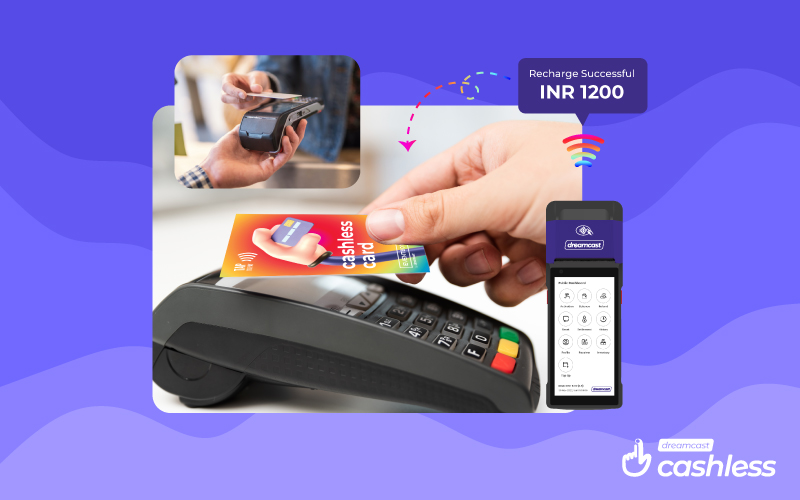Cashless payment methods have completely changed how businesses handle inventories in the fast-paced commercial world of today. Businesses can increase efficiency, improve accuracy, and simplify operations by incorporating cashless payment solutions into inventory management procedures. Let’s examine the role that cashless payment methods play in improving inventory control.
Importance Of Cashless Payment System For Inventory Management

Tracking Transactions in Real Time:
Businesses may track transactions as they happen with cashless payment systems, which gives them real-time inventory level updates. This implies that every transaction done using a cashless method—a credit card, a mobile payment, or a digital wallet—is immediately documented in the system. Businesses can analyze sales patterns, discover popular items, and make data-driven choices to enhance their inventory management strategies thanks to this real-time tracking, which keeps them always aware of their stock levels. Businesses can proactively replenish products, for instance, if they are selling fast to prevent stockouts and effectively fulfill client demand.
Reduced Human Error
Errors from manual transaction entry might cause inconsistencies and inefficiencies in inventory data. By automating the payment process, cashless payment systems greatly lower the possibility of human mistakes while recording transactions. Businesses can manage ideal stock levels, prevent stockouts or overstocking, and increase inventory turnover rates with the use of precise inventory data. In addition to increasing accuracy, this automation frees up staff members’ time from manual data entry duties so they can concentrate on more strategically important parts of inventory management, such as demand planning and forecasting.
Increased Visibility of Inventory:
With thorough statistics and analytics, cashless payment solutions provide improved visibility into inventory levels and movement. Companies may use data like sales patterns, best-selling items, and seasonal variations in demand to influence their inventory management decisions. To maximize space and save carrying costs, firms may identify fast-selling products and make sure they are always in stock, as well as slow-moving inventory that may need promotions or clearance. Additionally, modern warehouse kitting can improve inventory management by preparing pre-assembled kits of items to meet demand, reducing time in fulfilling customer orders.
Connecting Point-of-Sale Systems and Inventory:

Inventory management procedures are streamlined when point-of-sale (POS) systems are integrated with cashless payment systems. The POS system immediately updates the inventory when a consumer makes a purchase using a cashless method, like a credit card or mobile payment. This integration guarantees accurate inventory records across all sales channels, removes the need for human inventory changes, and lowers the possibility of disparities between sales and inventory data. Additionally, it reduces administrative burden and boosts overall inventory transaction management effectiveness.
Enhanced Experience for Customers:
The smooth and convenient customer experience that cashless payment systems provide can result in higher sales and repeat business. Consumers who use digital wallets, contactless cards, or mobile payments value the convenience and quickness of cashless transactions. Businesses may better serve a wide range of consumer preferences and increase customer satisfaction by providing a seamless checkout experience and a variety of cashless payment methods. Customers are more likely to make repeat purchases and refer the firm to others when they have a great payment experience, which boosts revenue and customer loyalty.
Steps to Prevent Fraud:
Systems for cashless payments frequently have strong security measures in place to thwart fraudulent transactions. Tokenization, sophisticated encryption technology, and authentication procedures protect client information and stop illegal access. Businesses can reduce the risk of fraud, protect critical client data, and foster consumer trust by putting security first. Businesses can function with confidence thanks to this security emphasis since they know that their Cashless payment system for inventory management can handle safe transactions and safeguard both the company and its clients.
Accuracy of Inventory Forecasting:
Businesses may improve the accuracy of inventory forecasting by utilizing the important data that the cashless payment system for inventory management offers. Businesses may enhance their forecasting models by examining sales trends, consumer behavior, and purchasing patterns obtained from cashless transactions. As a result, they can better predict demand, modify inventory levels appropriately, and prevent stockouts or surplus inventory. Precise inventory forecasting enhances overall operational efficiency, optimizes stock levels, and helps make better judgments about inventory management.

Effective Order Processing:
Cashless payment system for inventory management makes order fulfillment more efficient. Businesses can properly and quickly fulfill orders with accurate inventory data and real-time transaction tracking. Orders from customers can be processed and sent on time if warehouse or inventory management teams get automated notifications reminding them to restock supplies as needed. Order fulfillment efficiency lowers lead times, improves customer satisfaction, and raises the possibility of repeat business.
Enhanced Storage Administration:
Warehouse management may be enhanced by integrating cashless payment systems with inventory management software. Data analytics may be used by businesses to pinpoint inefficiencies in warehouse operations. It includes rates of inventory turnover, picking and packing procedures, and storage space use. Through data-driven insights-driven warehouse optimization, companies may save storage costs, expedite order processing, and enhance supply chain efficiency.
Simplified Exchanges and Returns:
Cashless payment systems improve inventory management procedures for product returns and consumer refunds by streamlining exchanges and returns. Returned products are appropriately accounted for in inventory records thanks to automated refund processing, inventory changes, and reconciliation with sales data. By offering a smooth returns experience, this optimization of exchanges and returns lowers administrative load, increases inventory accuracy, and improves customer happiness.
Integration with Inventory Management Software:
A smooth data flow between payment transactions and inventory records is made possible by the interface that many cashless payment systems offer with inventory management software. Businesses can now measure sales success, obtain complete inventory information, and more accurately assess inventory turnover rates thanks to this connectivity. Businesses may automate inventory-related operations, streamline inventory management workflows, and make well-informed choices by utilizing the power of integrated systems.
Supply Chain Transparency

Through the provision of real-time data on inventory levels, supplier activities, and order fulfillment procedures, cashless payment solutions help to improve supply chain visibility. Companies may follow the flow of goods from suppliers to warehouses to consumers to learn more about the effectiveness of their logistics and supply chains. Businesses may successfully satisfy consumer demand by identifying any bottlenecks, optimizing supplier relationships, and improving inventory replenishment methods thanks to this visibility.
Sustainability of the Environment:
By decreasing waste, increasing digital transactions, and decreasing paper-based transactions, the adoption of cashless payment systems is in line with environmental sustainability efforts. Businesses encourage environmentally friendly activities and help create a better environment by encouraging customers to embrace cashless payment alternatives. Furthermore, there is less need for paper documentation when cashless transactions produce digital receipts and electronic records. It makes inventory management and corporate operations more environmentally friendly.
Best Tips to Use Cashless Payment Systems to Improve Inventory Management
- Real-Time Sales Tracking: Make use of cashless payment systems to monitor sales in real-time, keeping track of inventory levels and spotting products that are in great demand.
- Automated Inventory Updates: To cut down on human error, integrate your cashless system with inventory management software to automatically update stocks with every transaction.
- Determine Popular Product: To manage stock levels and give priority to popular goods, analyze transaction data to determine best-selling items.
- Monitor Low Stock Alerts: To ensure prompt replenishing, set up low-stock alerts in the cashless payment system to get messages when inventory hits a certain level.
- Forecast Seasonal Trends: To forecast seasonal demand and schedule inventory purchases appropriately, use the system’s past sales data.
- Streamline Supply Chain: Simplify the supply chain by sharing inventory information with suppliers to improve cooperation and guarantee that you never overstock.
- Minimize Overstocking and Waste: Make educated purchase choices by using analytics from cashless systems to cut down on overstocking risks and waste from unsold Products.
In summary
The integration of cashless payment system for inventory management yields several advantages, such as the ability to track transactions in real-time, minimize human error, increase inventory visibility, integrate with point-of-sale systems, enhance customer experience, and prevent fraud. Companies that use cashless payment systems increase revenue, improve customer happiness, and streamline inventory management to obtain a competitive advantage.
FAQs
Cashless payment systems offer real-time transaction tracking, which allows event organizers to monitor sales and inventory levels instantly. This improves inventory management by providing accurate data on stock levels, sales trends, and popular items during the event.
Cashless payment systems automate payment processes, reducing the risk of human error in recording transactions. This leads to accurate inventory data, optimal stock levels, and improved inventory turnover rates, ensuring smoother operations for event organizers.
Cashless payment systems provide detailed reports and analytics on inventory levels and movement, enabling event organizers to make informed decisions. This visibility helps in proactive inventory management, such as restocking fast-selling items and clearing slow-moving inventory during the event.
Integrating cashless payment systems with POS systems streamlines inventory management by automatically updating inventory data with each cashless transaction. This integration ensures accurate inventory records across all sales channels, reducing administrative tasks and improving efficiency for event organizers.






